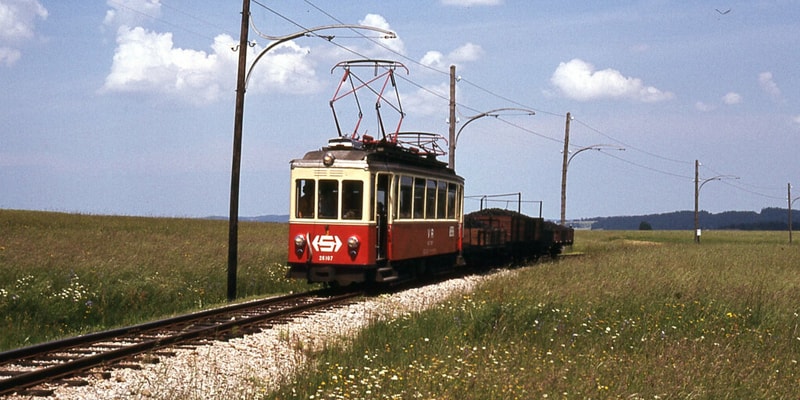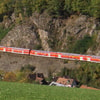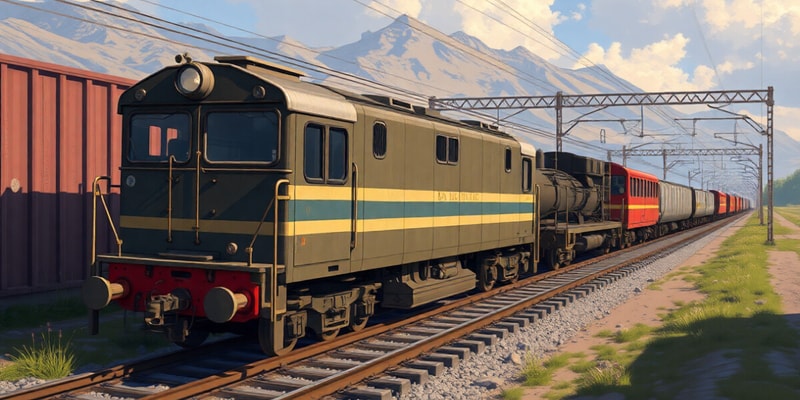Podcast
Questions and Answers
What is primarily responsible for guiding a Railway vehicle?
What is primarily responsible for guiding a Railway vehicle?
What happens if the cone angle of the wheelset is excessive?
What happens if the cone angle of the wheelset is excessive?
What is the recommended concity based on calculation and experience?
What is the recommended concity based on calculation and experience?
How much contact is typically made between the wheelset and the rail within normal conditions?
How much contact is typically made between the wheelset and the rail within normal conditions?
Signup and view all the answers
What determines the trajectories of a TGV wheel set's contact with the rail?
What determines the trajectories of a TGV wheel set's contact with the rail?
Signup and view all the answers
What is the maximum allowed angular amplitude of the oscillatory graph movements?
What is the maximum allowed angular amplitude of the oscillatory graph movements?
Signup and view all the answers
What does the contact between rail and wheel not exceed under normal conditions?
What does the contact between rail and wheel not exceed under normal conditions?
Signup and view all the answers
What critical factor affects the ideal situation of wheelset guiding?
What critical factor affects the ideal situation of wheelset guiding?
Signup and view all the answers
What is the expected wavelength of hunting under normal conditions?
What is the expected wavelength of hunting under normal conditions?
Signup and view all the answers
What is the effect of abnormal running surface wear on guiding?
What is the effect of abnormal running surface wear on guiding?
Signup and view all the answers
What is the primary function of ballast in railway construction?
What is the primary function of ballast in railway construction?
Signup and view all the answers
What does cant deficiency refer to in railway terms?
What does cant deficiency refer to in railway terms?
Signup and view all the answers
Which term describes the longitudinal movement of rails?
Which term describes the longitudinal movement of rails?
Signup and view all the answers
What is meant by the term 'cross level' in railway terminology?
What is meant by the term 'cross level' in railway terminology?
Signup and view all the answers
How is gauge defined in railway context?
How is gauge defined in railway context?
Signup and view all the answers
What does a deep flange refer to?
What does a deep flange refer to?
Signup and view all the answers
What is a 'switch' in terms of railway track components?
What is a 'switch' in terms of railway track components?
Signup and view all the answers
Which term refers to the flat surface prepared for laying railway tracks?
Which term refers to the flat surface prepared for laying railway tracks?
Signup and view all the answers
What does 'sharp flange' indicate in railway terminology?
What does 'sharp flange' indicate in railway terminology?
Signup and view all the answers
What is the role of flange force in railway movement?
What is the role of flange force in railway movement?
Signup and view all the answers
What occurs if the cone angle of a wheelset is insufficient?
What occurs if the cone angle of a wheelset is insufficient?
Signup and view all the answers
How is the contact area between the wheelset and the track affected under normal conditions?
How is the contact area between the wheelset and the track affected under normal conditions?
Signup and view all the answers
In regard to track parameters impacting wheelset guidance, which factor is NOT mentioned?
In regard to track parameters impacting wheelset guidance, which factor is NOT mentioned?
Signup and view all the answers
What defines the critical speed limit regarding wheelset guidance?
What defines the critical speed limit regarding wheelset guidance?
Signup and view all the answers
What is the hunting wavelength calculated to be under normal conditions?
What is the hunting wavelength calculated to be under normal conditions?
Signup and view all the answers
What relationship do the oscillatory movements and hunting movements have?
What relationship do the oscillatory movements and hunting movements have?
Signup and view all the answers
What is the consequence of excessive cone angles in regards to wheelsets?
What is the consequence of excessive cone angles in regards to wheelsets?
Signup and view all the answers
What is NOT a characteristic of the cone angle's effect on wheelsets?
What is NOT a characteristic of the cone angle's effect on wheelsets?
Signup and view all the answers
What is the maximum angular amplitude allowed for the oscillatory movements?
What is the maximum angular amplitude allowed for the oscillatory movements?
Signup and view all the answers
What is the primary purpose of the flanges in railway vehicles?
What is the primary purpose of the flanges in railway vehicles?
Signup and view all the answers
What does cant deficiency specifically indicate in railway operations?
What does cant deficiency specifically indicate in railway operations?
Signup and view all the answers
Which of the following best describes the term 'cross level' in railway systems?
Which of the following best describes the term 'cross level' in railway systems?
Signup and view all the answers
What characteristic defines a 'deep flange' in rail terminology?
What characteristic defines a 'deep flange' in rail terminology?
Signup and view all the answers
In railway terminology, what does the term 'gradient' refer to?
In railway terminology, what does the term 'gradient' refer to?
Signup and view all the answers
Which statement accurately defines 'point and crossing' in railway engineering?
Which statement accurately defines 'point and crossing' in railway engineering?
Signup and view all the answers
What is characterized by the hollow tyre exceeding 5 mm?
What is characterized by the hollow tyre exceeding 5 mm?
Signup and view all the answers
What does the term 'flange force' refer to in railway contexts?
What does the term 'flange force' refer to in railway contexts?
Signup and view all the answers
Which option best describes the formation in railway construction?
Which option best describes the formation in railway construction?
Signup and view all the answers
What does 'gauge' measure in the context of railways?
What does 'gauge' measure in the context of railways?
Signup and view all the answers
What condition does 'creep' describe in railway tracks?
What condition does 'creep' describe in railway tracks?
Signup and view all the answers
Study Notes
Railway Vehicle Guiding
- Railway vehicle guidance is primarily ensured by visco-elastic contact forces between the conical wheel surfaces and cylindrical rail surfaces
- Abnormal running surfaces, excessive or deficient cant, and switch/crossing work can disrupt this normal operation
- Wheel flange contact acts as a secondary stop for exceptional circumstances
- Insufficient cone angle leads to constant flange contact, a problem for the design
- The guiding of a Railway vehicle is primarily affected by the visco-elastic forces between the wheel cones and rail cylinders
- Flanges are just a secondary safeguard for unusual situations
Wheelset Restoring Force
- Excessive restoring force is undesirable, especially in short-wave lengths (e.g., less than 20 meters)
- The optimal concity, based on calculations and experience, is around 1/40 or 0.025
- Hunting can result from improper concity, possibly from an oscillating behavior
- Excessive restoring force is problematic, especially in short waves (e.g., less than 20 meters)
- Restoring force relies heavily on the cone angle for smooth operation
- Correct alignment creates smooth transitions without significant disturbances
Wheel-Rail Contact
- Wheel-rail contact is confined to a small area of the total available clearance (typically 8 mm)
- Rail and track parameters influence the movement of the wheel set
- Wheel movements are not random and generally follow consistent patterns
- Contact is largely confined to a narrow section, usually 8mm, of potential clearance
- The wheel's movement on the rail is guided by track characteristics and is not arbitrary
Oscillatory Movement
- Oscillatory movements are coordinated with hunting movements, showing a consistent pattern
- Amplitude of these oscillatory movements doesn't exceed 2.5 meters (approximately 10 minutes of arc)
- External factors affect the ideal situation created by the critical speed
- Oscillations align with hunting movements and maintain a consistent pattern
- The angular amplitude of these oscillations stays within 2.5 meters radius (about 10 minutes of arc)
Glossary
- Ballast : Material used to cushion sleepers and the formation top.
- Cant/Superelevation: Outer rail on curves is elevated above the inner rail to offset centrifugal forces.
- Cant deficiency: Difference between the necessary cant for maximum speed and the actual cant provided.
- Cross level: Relative difference in vertical levels between the left and right rails.
- Creep: Longitudinal movement of rails.
- Deep flange: When flange depth surpasses 35 mm
- Flange force: Force generated by wheel flange during wheel movement.
- Formation: Flat earthwork surface for track laying.
- Gauge: Distance between the two running edges of the rails
- Gradient: Amount of incline/decline of a railway track.
- Hollow tyre: Tyre with depression exceeding 5 mm in depth.
- Point & Crossing: System to allow trains to switch tracks
- Running edge of the rail: Rail edge where wheel flange contacts the rail.
- Sharp flange: Flange edge having a radius less than 5mm at its tip, suggesting wear
- Stock rail: Rail on the main line that tongue rails connect to
- Switch: Area where a train track changes direction, typically composed of stock and tongue rails
- Tongue rail: Tapered rail that forms part of the switch assembly; one end is thicker ("Heel") and fixed, the other thinner ("Toe")
- Thin flange: Flange thickness less than 16mm
- Throw of switch: Distance tongue rails travel at the toe of the switch.
- Twist: Rate of cross-level change per meter
- Transition of curve: Smooth curve sections in railway lines to avoid abrupt changes in curve degree
- Wheel base: Distance between adjacent axles on a bogie
- Wheel gauge: Distance between inner edges of wheel flanges on an axle.
Studying That Suits You
Use AI to generate personalized quizzes and flashcards to suit your learning preferences.
Related Documents
Description
This quiz explores the dynamics of railway vehicle guidance, focusing on the roles of wheel-rail contact and restoring forces. It discusses critical design parameters and the impact of various track conditions on vehicle stability. Test your knowledge on optimal wheelset design and the significance of contact forces in railway systems.




